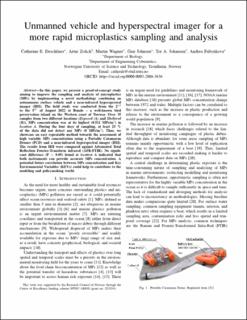| dc.contributor.author | Deschenes, C | |
| dc.contributor.author | Zolich, Artur | |
| dc.contributor.author | Wagner, Martin | |
| dc.contributor.author | Johnsen, Geir | |
| dc.contributor.author | Johansen, Tor Arne | |
| dc.contributor.author | Faltynkova, Andrea | |
| dc.date.accessioned | 2024-02-09T10:15:11Z | |
| dc.date.available | 2024-02-09T10:15:11Z | |
| dc.date.created | 2023-12-22T15:44:21Z | |
| dc.date.issued | 2023 | |
| dc.identifier.citation | OCEANS. 2023, 1-10. | en_US |
| dc.identifier.issn | 0197-7385 | |
| dc.identifier.uri | https://hdl.handle.net/11250/3116571 | |
| dc.description.abstract | In this paper, we present a proof-of-concept study aiming to improve the sampling and analysis of microplastics (MPs) by implementing a novel methodology combining an autonomous surface vehicle and a near-infrared hyperspectral imager (HSI). The field study was conducted from the 2 nd to the 5 th of August 2022 at Runde – a well-known bird preservation island on the Western coast of Norway. Over 35 samples from two different locations (Exposed (A) and Sheltered (B)), MPs concentration was at its highest (0.511 MPs/m 3 ) in location A. During the four days of sampling, at least 25 % of the data did not detect any MPs (0 MPs/m 3 ). Thus, we showcase an easy repeatable method towards the assessment of high variable MPs concentration using a Portable Catamaran Drones (PCD) and a near-infrared hyperspectral imager (HSI). The results from HSI were compared against Attenuated Total Reflection Fourier-Transform infrared (ATR-FTIR). No significant difference ( P>0.05 ) found at location A indicated that both instruments can provide accurate MPs concentration. A potential future correlation between MPs concentration and Key Environmental Variables (KEVs) could help to contribute to the modeling and policymaking world. | en_US |
| dc.language.iso | eng | en_US |
| dc.publisher | IEEE | en_US |
| dc.title | Unmanned vehicle and hyperspectral imager for a more rapid microplastics sampling and analysis. | en_US |
| dc.title.alternative | Unmanned vehicle and hyperspectral imager for a more rapid microplastics sampling and analysis. | en_US |
| dc.type | Journal article | en_US |
| dc.description.version | acceptedVersion | en_US |
| dc.rights.holder | © 2023 IEEE. Personal use of this material is permitted. Permission from IEEE must be obtained for all other uses, in any current or future media, including reprinting/republishing this material for advertising or promotional purposes, creating new collective works, for resale or redistribution to servers or lists, or reuse of any copyrighted component of this work in other works. | en_US |
| dc.source.pagenumber | 1-10 | en_US |
| dc.source.journal | OCEANS | en_US |
| dc.identifier.doi | 10.23919/OCEANS52994.2023.10337204 | |
| dc.identifier.cristin | 2217357 | |
| dc.relation.project | Norges forskningsråd: 223254 | en_US |
| cristin.ispublished | true | |
| cristin.fulltext | postprint | |
| cristin.qualitycode | 0 | |
